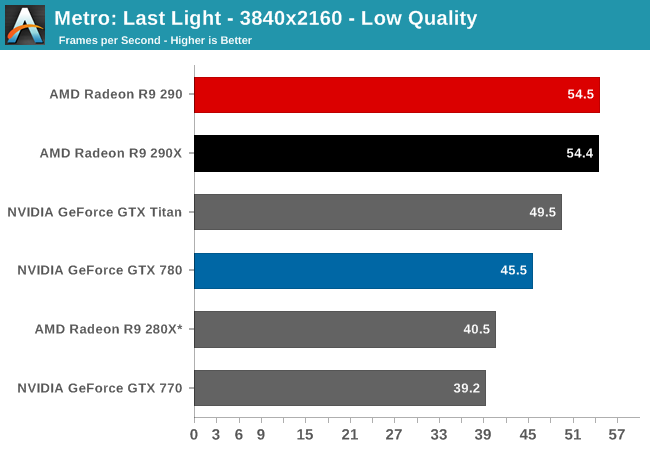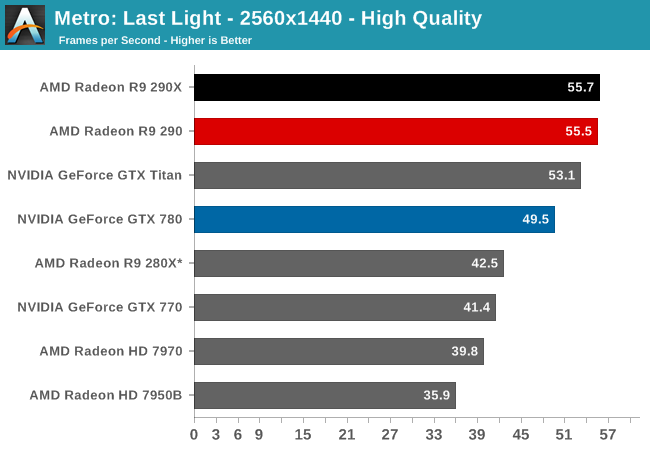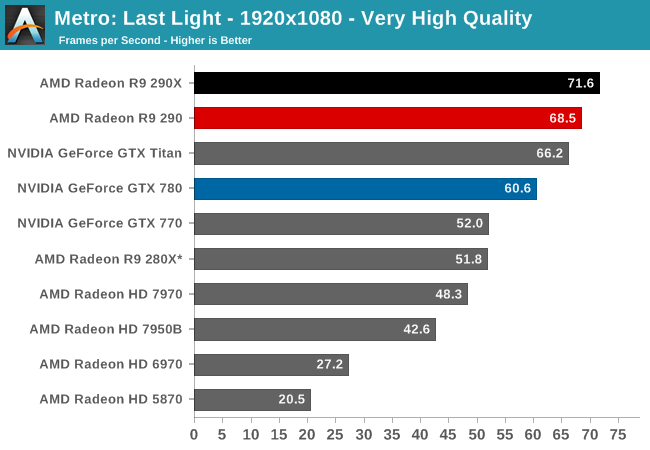The AMD Radeon R9 290 Review
by Ryan Smith on November 5, 2013 12:01 AM EST- Posted in
- GPUs
- AMD
- Radeon
- Hawaii
- Radeon 200
Metro: Last Light
As always, kicking off our look at performance is 4A Games’ latest entry in their Metro series of subterranean shooters, Metro: Last Light. The original Metro: 2033 was a graphically punishing game for its time and Metro: Last Light is in its own right too. On the other hand it scales well with resolution and quality settings, so it’s still playable on lower end hardware.



For the bulk of our analysis we’re going to be focusing on our 2560x1440 results, as monitors at this resolution will be what we expect the 290 to be primarily used with. A single 290 may have the horsepower to drive 4K in at least some situations, but given the current costs of 4K monitors that’s going to be a much different usage scenario. The significant quality tradeoff for making 4K playable on a single card means that it makes far more sense to double up on GPUs, given the fact that even a pair of 290Xs would still be a fraction of the cost of a 4K, 60Hz monitor.
With that said, there are a couple of things that should be immediately obvious when looking at the performance of the 290.
- It’s incredibly fast for the price.
- Its performance is at times extremely close to the 290X
To get right to the point, because of AMD’s fan speed modification the 290 doesn’t throttle in any of our games, not even Metro or Crysis 3. The 290X in comparison sees significant throttling in both of those games, and as a result once fully warmed up the 290X is operating at clockspeeds well below its 1000MHz boost clock, or even the 290’s 947MHz boost clock. As a result rather than having a 5% clockspeed deficit as the official specs for these cards would indicate, the 290 for all intents and purposes clocks higher than the 290X. Which means that its clockspeed advantage is now offsetting the loss of shader/texturing performance due to the CU reduction, while providing a clockspeed greater than the 290X for the equally configured front-end and back-end. In practice this means that 290 has over 100% of 290X’s ROP/geometry performance, 100% of the memory bandwidth, and at least 91% of the shading performance.
So in games where we’re not significantly shader bound, and Metro at 2560 appears to be one such case, the 290 can trade blows with the 290X despite its inherent disadvantage. Now as we’ll see this is not going to be the case in every game, as not every game GPU bound in the same manner and not every game throttles on the 290X by the same degree, but it sets up a very interesting performance scenario. By pushing the 290 this hard, and by throwing any noise considerations out the window, AMD has created a card that can not only threaten the GTX 780, but can threaten the 290X too. As we’ll see by the end of our benchmarks, the 290 is only going to trail the 290X by an average of 3% at 2560x1440.
Anyhow, looking at Metro it’s a very strong start for the 290. At 55.5fps it’s essentially tied with the 290X and 12% ahead of the GTX 780. Or to make a comparison against the cards it’s actually priced closer to, the 290 is 34% faster than the GTX 770 and 31% faster than the 280X. AMD’s performance advantage will come crashing down once we revisit the power and noise aspects of the card, but looking at raw performance it’s going to look very good for the 290.










295 Comments
View All Comments
carlob - Saturday, December 7, 2013 - link
At the top of the card, above first row of memory chips, there is one micro switch. If i see well, it's written SW1.Does anybody know what is the purpose of the switch? Thanks.
jonabatero - Thursday, December 19, 2013 - link
HELLO: guys test the R9 290 with LUMION 3D . please .could someone please test the performance of the R9 290 with Lumion 3d. serial great buy with the performance of a GTX 770 in Lumion
xaml - Sunday, December 22, 2013 - link
"Ultimately there will be scenarios where this is acceptable – namely, anything where you don’t have to hear the 290, such as putting it in another room or putting it under water (...)."Or the scenario, the one that's neither unreasonable nor rare, which was conveniently left out, namely playing with a headset. I understand, however, that there has to be a balance between more powerful fans and their noise output, especially with cards which typically grew in size, yet reaching a point where both the cards as well as their fans cannot further grow. A truly negative review would have been one where the fan was loud and where it wouldn't adequately support the airflow.
c1phertxt - Tuesday, December 24, 2013 - link
I don't think a lot of people realise how hot this card gets under load. I have a CM HAF XB and an XFX R9 290.When the card is at 100% load, the existing "fan-temp" curve is insufficient to prevent throttling. I see the temps stabilising at 95 C while the fan is at 46%. As a result clocks throttle down to 662 Mhz. I have to set a custom fan profile that sets the fan to atleast 65% to keep the temps at 85C. Even then, the clocks go down to 850Mhz (a 100 Mhz throttle).
Anything over 65% fan speed is deafening (sounds like a blow dryer and at 80%+ it sounds like a vacum cleaner).
Seriously contemplating putting this under water or getting an after market cooler.
jaris - Thursday, June 19, 2014 - link
Been gaming since the mid 70's, so fairly seasoned, the review is good upto the point regards noise, then it becomes silly. Most gamers don't sit in the front room playing whilst the wife watches tv, well I don't, plus I like loud, thats why i use a headset, all the time. R290 is going into my i7 4790k, like quickly. Might have to close the den door a little but well... I have a very decent headset, won't hear anything other than the game playing. ;)